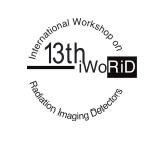Speaker
Mr
Frantisek Krejci
(IEAP CTU in Prague)
Description
The state-of-the-art hybrid semiconductor pixel detector Timepix allows direct measurement of energy of each detected particle. Based on this detection principle, completely new applications like energy sensitive (color) X-ray radiography or fluorescent X-ray imaging have been introduced. The performance of these methods (for example the feasibility to separate two different materials in the radiogram) is given by the spectral resolution of the detector.
The energy resolution of the pixelated detector is, however, influenced by the charge sharing effect. This effect originates from the fact that the charge created by the incoming particle spreads out between several adjacent pixels (depending on the place of interaction and detector parameters). In the single particle counting detectors, the charge collected in each pixel is compared with a certain threshold level and, if it is lower, the event is not registered and the charge is lost. As a consequence, the energy resolution of these detectors is deteriorated.
In this contribution we present a novel approach for characterization of semiconductor pixel detectors using X-rays. We use a precise gold grid placed in front of the sensor chip, segmenting the incoming X-ray beam into a matrix of precisely defined micro-beams irradiating all the detector pixels in known positions. The proper analysis of obtained moiré pattern allows evaluation the charge sharing effect and determination of its influence to spectrometric properties of the detector. Instead of a synchrotron source, simply the fluorescent radiation generated by a standard X-ray tube can be used as a source of monochromatic X-rays. The size of all micro-beams is limited just by the production technology of the aperture. As opposed to currently used micro-beam studies realized at synchrotron sources, the whole pixel matrix is investigated at once. This offers a great tool for the investigation of charge sharing phenomena and verification of theoretical works dedicated to these detectors.
The similar absorption grid can be used for masking of pixel borders suppressing the charge sharing effect. This approach significantly improves the spectrometric properties of pixelated detector at the cost of lower detection efficiency. This technique can be used for energy sensitive X-ray imaging of inanimate objects where the radiation dose does not present an issue.
Primary author
Mr
Frantisek Krejci
(IEAP CTU in Prague)
Co-authors
Dr
Jan Jakubek
(IEAP CTU in Prague)
Dr
Karel Hruska
(Institute of physics, CAS)
Mr
Martin Kroupa
(IEAP CTU in Prague)
Dr
Vlastimil Jurka
(Institute of physics, CAS)
